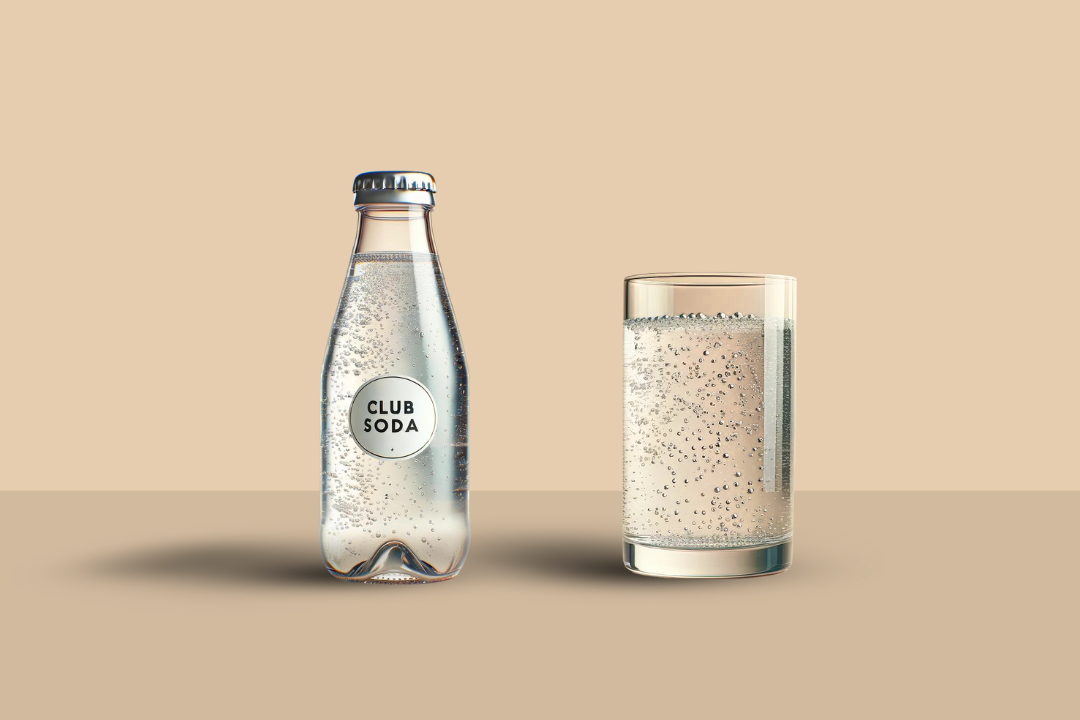
Club Soda vs Sparkling Water: What's the Difference?

What's the difference between club soda vs sparkling water?
The main difference between club soda and sparkling water lies in their mineral content. Although both are artificially infused with carbon dioxide, club soda takes it a step further by infusing additional minerals.
When choosing a fizzy drink, many people often wonder about the distinction between club soda and sparkling water.
Though they may look similar, there are key differences that set them apart as all carbonated beverages are not always the same.
Table of contents

Why is it called club soda?
Club soda got its name in the early 19th century when it was created as a mixer for drinks in social clubs.
The infused minerals found in club soda made it a popular choice in clubs and bars for enhancing cocktails, leading to its adoption of the name "club soda."
Ingredients in club soda
Club soda is a favored beverage for many, celebrated for its added minerals that elevate both flavor and texture. Here are the typical ingredients found in club soda:
These additional minerals not only contribute to the taste and mouthfeel but also differentiate club soda from other fizzy beverages like sparkling water.
Let's break down each of these ingredients to further understand their use and purpose in club soda.

Carbon dioxide
Carbon dioxide is the key ingredient that gives club soda its characteristic fizz and bubbles. When carbon dioxide gas is dissolved in water under pressure, it creates carbonic acid, which slightly acidifies the beverage.
Carbon dioxide is crucial for creating the bubbly texture that many people find refreshing. Although it does not contribute to the nutritional value of the beverage in terms of calories, its role in creating a pleasurable drinking experience cannot be underestimated.
Sodium bicarbonate
Sodium bicarbonate, commonly known as baking soda, serves multiple roles in club soda.
It acts as a buffer to neutralize acidity, ensuring the beverage maintains a balanced pH level. This contributes to the smooth, slightly tangy taste of club soda.
Sodium bicarbonate also imparts a subtle salty flavor, which makes it an excellent and classic mixer in cocktails.
Related read: What's the Difference Between Tonic Water vs Club Soda?

Sodium chloride
The primary role of sodium chloride, or table salt, is to improve the taste by adding a hint of saltiness to club soda. This ingredient is found in many other carbonated beverages and helps to balance out the flavors present.
Potassium sulfate
Potassium sulfate is included in club soda for its salinity and preservative qualities. It provides a slight bitter-salty taste which adds to the unique profile of club soda.
Potassium sulfate also helps to moderate the acidic nature of the drink.

Disodium phosphate
Disodium phosphate serves as an emulsifier and buffering agent in club soda. It helps to maintain the beverage's consistency and stability, preventing any separation of ingredients.
By regulating acidity levels, disodium phosphate ensures that club soda remains consistently pleasant to drink over time.
In summary, understanding these ingredients sheds light on the key differences between club soda stands and sparkling water and allows you to have full transparency in the mineral contents you may be consuming regularly.
Related read: Mineral water vs sparkling water: What's the difference?
Key factors of sparkling water compared to club soda
Sparkling water has its own unique properties and characteristics that differentiate it from club soda. Unlike club soda, sparkling water typically does not contain added minerals, which can result in a crisper and cleaner taste– making its ingredient list quite short in comparison.
Here are the core attributes of sparkling water:
- Sparkling water is artificially carbonated by dissolving carbon dioxide under pressure, similar to club soda.
- Sparkling water usually lacks the added minerals found in club soda, making it a purer form of carbonated water. This can appeal to those preferring a less salty and more neutral flavor profile.
- Due to its neutral taste, sparkling water is a versatile option for mixing with various beverages, including juices and spirits, or simply enjoyed on its own. It is often chosen by individuals seeking hydration without added flavors or minerals.
- Sparkling water is the easiest carbonated water to make right from home. Typically only needing a sparkling water maker and a CO2 canister, you can have seemingly endless sparkling water right at your fingertips.
Related read: What are the Differences Between Seltzer and Sparkling Water?

There's also natural sparkling water
One distinct type of sparkling water worth mentioning is natural sparkling water, also referred to as sparkling mineral water, which comes from mineral springs and contains natural carbonation, along with a variety of naturally occurring minerals like calcium, magnesium, and potassium.
Examples include popular brands like San Pellegrino, Perrier, and Gerolsteiner. Some key factors when considering natural sparkling water are:
- Natural sparkling water comes from natural springs and is bottled at the source, retaining its original mineral content and natural carbonation.
- The naturally occurring minerals can provide slight health benefits, such as calcium for bone health and magnesium for muscle function.
- The taste of natural sparkling water can vary based on its mineral composition, often offering a more complex flavor profile compared to artificially carbonated sparkling water.

Summary
In conclusion, both club soda and sparkling water provide unique taste experiences and functional qualities. Club soda stands out due to added minerals such as sodium bicarbonate, sodium chloride, potassium sulfate, and disodium phosphate. These minerals not only enhance its taste but also improve its stability, making it a favored option in cocktails and among those who prefer a slightly salty flavor.
On the other hand, sparkling water provides a crisper, cleaner taste due to the absence of added minerals, appealing to those who prefer a neutral flavor profile.
Whether for mixing drinks, enjoying pure refreshment, or benefiting from natural minerals, understanding the differences between these refreshing beverages can help you make an informed choice based on your personal preference and hydration needs.
Recommended reading

How to Give Back During Thanksgiving 2025
Key takeaways Thanksgiving is a time to express gratitude and share with those in need. From volunteering at local shelters to donating food and essentials, there are numerous ways to give back to...

What Does Carbonation Do to Your Body?
What does carbonation do to your body? Carbonation alone typically has minimal effects; however, it can cause bloating and discomfort for some, and it may worsen acid reflux due to carbon dioxide ...

What Are the Health Benefits of Sparkling Water?
Summary Sparkling water isn't just a refreshing drink—it comes with surprising health benefits too. From aiding digestion to improving hydration, discover how sparkling water can be a healthy addi...